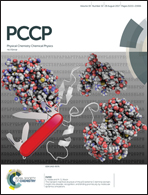Redox cycling of iron by carbon dot enhanced chemiluminescence: mechanism of electron–hole induction in carbon dot†
Abstract
The chemiluminescence (CL) of the Fenton system with nitrogen doped carbon dots (N-CDs) was significantly enhanced. The introduction of N-CDs improved the utilization of H2O2 and drastically enhanced the generation of ˙OH, which resulted in enhanced CL emission of the Fenton system through energy and electron transfer processes. The oxidation of N-CDs by ˙OH led to rapid incorporation of oxygen into N-CDs. The mechanism relied on the production of •OH radicals through the Fenton reaction and clearly indicated the important role of peroxide-induced redox cycling of Fe2+ ⇔ Fe3+ in the presence of N-CDs. The CL intensity of the system containing Fe2+ was higher than that containing Fe3+ because the rate of the Fe3+ reaction was much slower than that of the Fe2+ reaction. The CL signal remained constant after some time due to redox cycling, which established equilibrium, irrespective of the form of iron. This study provides a feasible approach to greatly enhance the weak CL of the Fenton system with the introduction of environmentally friendly N-CDs, and initiates an inspiring research in the domain of catalysis, CL and the mechanism of the Fenton system, which will be helpful in various applied research areas.



 Please wait while we load your content...
Please wait while we load your content...